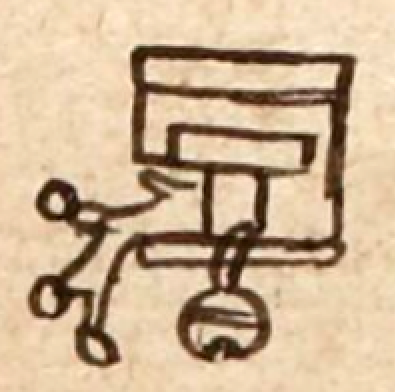Callalatl (Verg15v)
This black-line drawing of the compound glyph for the personal name Callalatl (“House Land-Water,” attested here as a man’s name) shows a house (calli) in profile facing toward the viewer's left. Three sprays of water (atl), each with a droplet or bead at the end, emerges from the entry way of the building. Hanging down from the bottom of the T-shaped doorway of the building is a round bell with horizontal stripes and an opening at the bottom for the sound to escape.
Stephanie Wood
The verb "to ring" (calani) is something of a homophone for house land (callalli). Thus, the bell seems to play a phonetic role to help the reader arrive at the sense of the water (irrigation) pertaining to house land, which was typically used for agricultural purposes, perhaps something like a kitchen garden. The term for outside is calan, which is also close here. Further research is required.
Stephanie Wood
matheo. calallatl
Mateo Callalatl
Stephanie Wood
1539
Jeff Haskett-Wood
casas, edificios, agua, cascabeles, campanillas, campanas, pinjantes, bells, suenan, metales, nombres de hombres

cal(li), house, https://nahuatl.wired-humanities.org/content/calli
a(tl), water, https://nahuatl.wired-humanities.org/content/atl
calani, to ring (as in a bell), https://nahuatl.wired-humanities.org/content/calani
callalli, cultivated house land, https://nahuatl.wired-humanities.org/content/callalli
Codex Vergara, folio 15v, https://gallica.bnf.fr/ark:/12148/btv1b84528032/f38.item.zoom
The non-commercial reuse of images from the Bibliothèque nationale de France is free as long as the user is in compliance with the legislation in force and provides the citation: “Source gallica.bnf.fr / Bibliothèque nationale de France” or “Source gallica.bnf.fr / BnF.” We would also appreciate a citation to the Visual Lexicon of Aztec Hieroglyphs, https://aztecglyphs.wired-humanities.org/.




